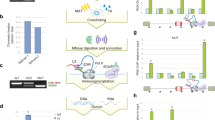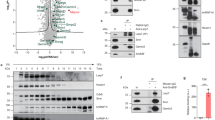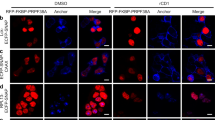Abstract
Transcription and pre-mRNA splicing are tightly coupled gene expression events in eukaryotic cells1,2. An interaction between the carboxy-terminal domain of the largest subunit of RNA polymerase (Pol) II and components of the splicing machinery is postulated to mediate this coupling3,4,5. Here, we show that splicing factors function directly to promote transcriptional elongation, demonstrating that transcription is more intimately coupled to splicing than previously thought. The spliceosomal U small nuclear ribonucleoproteins (snRNPs) interact with human transcription elongation factor TAT-SF1 (refs 6,7,8,9) and strongly stimulate polymerase elongation when directed to an intron-free human immunodeficiency virus-1 (HIV-1) template. This effect is likely to be mediated through the binding of TAT-SF1 to elongation factor P-TEFb10, a proposed component of the transcription elongation complex11,12. Inclusion of splicing signals in the nascent transcript further stimulates transcription, supporting the notion that the recruitment of U snRNPs near the elongating polymerase is important for transcription. Because the TAT-SF1–U snRNP complex also stimulates splicing in vitro, it may serve as a dual-function factor to couple transcription and splicing and to facilitate their reciprocal activation.
This is a preview of subscription content, access via your institution
Access options
Subscribe to this journal
Receive 51 print issues and online access
$199.00 per year
only $3.90 per issue
Buy this article
- Purchase on Springer Link
- Instant access to full article PDF
Prices may be subject to local taxes which are calculated during checkout




Similar content being viewed by others
References
Bentley, D. Coupling RNA polymerase II transcription with pre-mRNA processing. Curr. Opin. Cell Biol. 11, 347–351 (1999).
Hirose, Y. & Manley, J. L. RNA polymerase II and the integration of nuclear events. Genes Dev. 14, 1415–1429 (2000).
McCracken, S. et al. The C-terminal domain of RNA polymerase II couples mRNA processing to transcription. Nature 385, 357–361 (1997).
Fong, N. & Bentley, D. L. Capping, splicing, and 3′ processing are independently stimulated by RNA polymerase II: different functions for different segments of the CTD. Genes Dev. 15, 1783–1795 (2001).
Hirose, Y., Tacke, R. & Manley, J. L. Phosphorylated RNA polymerase II stimulates pre-mRNA splicing. Genes Dev. 13, 1234–1239 (1999).
Kim, J. B., Yamaguchi, Y., Wada, T., Handa, H. & Sharp, P. A. Tat-SF1 protein associates with RAP30 and human SPT5 proteins. Mol. Cell. Biol. 19, 5960–5968 (1999).
Li, X. Y. & Green, M. R. The HIV-1 Tat cellular coactivator Tat-SF1 is a general transcription elongation factor. Genes Dev. 12, 2992–2996 (1998).
Zhou, Q. & Sharp, P. A. Tat-SF1: cofactor for stimulation of transcriptional elongation by HIV-1 Tat. Science 274, 605–610 (1996).
Parada, C. A. & Roeder, R. G. A novel RNA polymerase II-containing complex potentiates Tat-enhanced HIV-1 transcription. EMBO J. 18, 3688–3701 (1999).
Price, D. H. P-TEFb, a cyclin-dependent kinase controlling elongation by RNA polymerase II. Mol. Cell. Biol. 20, 2629–2634 (2000).
Ping, Y. H. & Rana, T. M. Tat-associated kinase (P-TEFb): a component of transcription preinitiation and elongation complexes. J. Biol. Chem. 274, 7399–7404 (1999).
Zhou, M. et al. Tat modifies the activity of CDK9 to phosphorylate serine 5 of the RNA polymerase II carboxyl-terminal domain during human immunodeficiency virus type 1 transcription. Mol. Cell. Biol. 20, 5077–5086 (2000).
Dahmus, M. E. Reversible phosphorylation of the C-terminal domain of RNA polymerase II. J. Biol. Chem. 271, 19009–19012 (1996).
Wei, P., Garber, M. E., Fang, S. M., Fischer, W. H. & Jones, K. A. A novel CDK9-associated C-type cyclin interacts directly with HIV-1 Tat and mediates its high-affinity, loop-specific binding to TAR RNA. Cell 92, 451–462 (1998).
Jones, K. A. Taking a new TAK on tat transactivation. Genes Dev. 11, 2593–2599 (1997).
Garber, M. E. et al. The interaction between HIV-1 Tat and human cyclin T1 requires zinc and a critical cysteine residue that is not conserved in the murine CycT1 protein. Genes Dev. 12, 3512–3527 (1998).
Peng, J., Zhu, Y., Milton, J. T. & Price, D. H. Identification of multiple cyclin subunits of human P-TEFb. Genes Dev. 12, 755–762 (1998).
Fong, Y. W. & Zhou, Q. Relief of two built-in autoinhibitory mechanisms in P-TEFb is required for assembly of a multicomponent transcription elongation complex at the human immunodeficiency virus type 1 promoter. Mol. Cell. Biol. 20, 5897–5907 (2000).
Zhou, Q. & Sharp, P. A. Novel mechanism and factor for regulation by HIV-1 Tat. EMBO J. 14, 321–328 (1995).
Marciniak, R. A. & Sharp, P. A. HIV-1 Tat protein promotes formation of more-processive elongation complexes. EMBO J. 10, 4189–4196 (1991).
Yan, D. et al. CUS2, a yeast homolog of human Tat-SF1, rescues function of misfolded U2 through an unusual RNA recognition motif. Mol. Cell. Biol. 18, 5000–5009 (1998).
Perriman, R. & Ares, M. Jr ATP can be dispensable for prespliceosome formation in yeast. Genes Dev. 14, 97–107 (2000).
Krainer, A. R. Pre-mRNA splicing by complementation with purified human U1, U2, U4/U6 and U5 snRNPs. Nucleic Acids Res. 16, 9415–9429 (1988).
Bach, M., Bringmann, P. & Lührmann, R. Purification of small nuclear ribonucleoprotein particles with antibodies against modified nucleosides of small nuclear RNAs. Methods Enzymol. 181, 232–257 (1990).
Blencowe, B. J. & Lamond, A. I. Purification and depletion of RNP particles by antisense affinity chromatography. Methods Mol. Biol. 118, 275–287 (1999).
Schnapp, G., Rodi, H. P., Rettig, W. J., Schnapp, A. & Damm, K. One-step affinity purification protocol for human telomerase. Nucleic Acids Res. 26, 3311–3313 (1998).
Krainer, A. R. & Maniatis, T. Multiple factors including the small nuclear ribonucleoproteins U1 and U2 are necessary for pre-mRNA splicing in vitro. Cell 42, 725–736 (1985).
Solnick, D. Alternative splicing caused by RNA secondary structure. Cell 43, 667–676 (1985).
Padgett, R. A., Mount, S. M., Steitz, J. A. & Sharp, P. A. Splicing of messenger RNA precursors is inhibited by antisera to small nuclear ribonucleoprotein. Cell 35, 101–107 (1983).
Ares, M. Jr, Grate, L. & Pauling, M. H. A handful of intron-containing genes produces the lion's share of yeast mRNA. RNA 9, 1138–1139 (1999).
Acknowledgements
We thank B. Blencowe for the gift of antisense RNA oligonucleotide and advice on the depletion procedures; E. Labourier, D. Rio, J. Underwood, D. Black and H. Wu for reagents; E. Logue and L. Zhou for technical assistance; and K. Luo, I. von Reis and S. Stroschein for discussions. Supported by grants from the National Institutes of Health to Q.Z. and the University of California Universitywide AIDS Research Program to Y.W.F.
Author information
Authors and Affiliations
Corresponding author
Rights and permissions
About this article
Cite this article
Fong, Y., Zhou, Q. Stimulatory effect of splicing factors on transcriptional elongation. Nature 414, 929–933 (2001). https://doi.org/10.1038/414929a
Received:
Accepted:
Issue Date:
DOI: https://doi.org/10.1038/414929a
This article is cited by
-
RNA polymerase II pausing regulates chromatin organization in erythrocytes
Nature Structural & Molecular Biology (2023)
-
Differential fates of introns in gene expression due to global alternative splicing
Human Genetics (2022)
-
Splicing factor USP39 promotes ovarian cancer malignancy through maintaining efficient splicing of oncogenic HMGA2
Cell Death & Disease (2021)
-
A first exon termination checkpoint preferentially suppresses extragenic transcription
Nature Structural & Molecular Biology (2021)
-
Characterization of the human TARDBP gene promoter
Scientific Reports (2021)
Comments
By submitting a comment you agree to abide by our Terms and Community Guidelines. If you find something abusive or that does not comply with our terms or guidelines please flag it as inappropriate.



